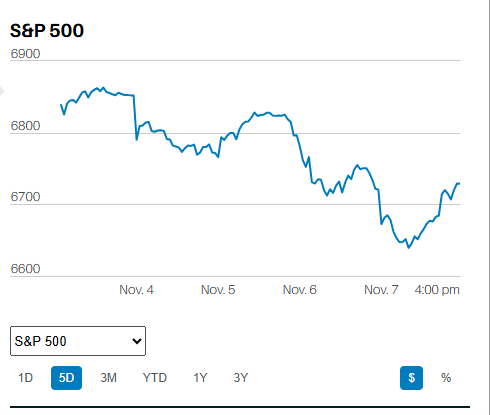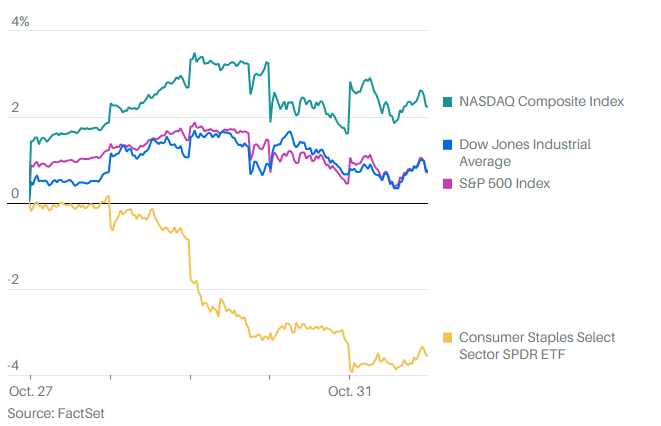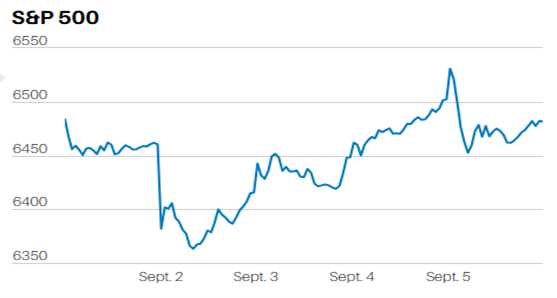WE Continue to buy good companies when they go on sale

Market Update
The S&P 500 finished the week at 4605.38. It set a record Friday of 4608.08. Earnings are coming in strong. Inflation readings are still high. The Fed is meeting this week and is expected to announce a taper timeline. Tapering is tightening and tightening means higher interest rates. Higher interest rates will slow down the economy. The goal is to avoid sustained inflation. Tightening cycles end in a stock market correction and often a bear market. It can be years before that happens though.
The world economy is still opening. Economically sensitive stocks should continue to perform well. Rising interest rates will pressure longer-duration assets. Think intermediate and long-term bonds and high price-to-earnings-growth stocks. Value outperforms growth over the long run by around 4.3% per annum. The only 10-year periods where growth has beat value are during the 1930s and 2010s. Both periods experienced severe economic distress and extreme monetary and fiscal policies. Value is likely to outperform growth for the foreseeable future.
Economic Update
The Chicago National Activity Index three-month average was 0.25 in September down from 0.38 the prior month. The indicator signals slow growth. The Case Shiller home price index rose 19.8% in August. Home prices continue to rise far faster than normal. Rising interest rates will slow activity at some point but clearly not yet. Consumer confidence rose to 113.8 in October from 109.8 the prior month. Falling consumer confidence has concerned some economists. Consumers have Covid savings available to spend though. The spending should continue to support the economy.
Core capital goods spending rose 0.8% in September up from 0.5% in August. Business investment makes up about 20% of the economy. Increasing core capital goods spending is a positive sign. However, the big number was third-quarter GDP which was 2.0% compared to 6.7% in Q2. The sharp slowdown was not unexpected. The Atlanta Fed GDPNow forecast was 1.2% just two weeks before the release. It remains to be seen whether the economy will reaccelerate as many economists expect. Goldman Sachs forecasts full-year GDP growth for 2021 of 5.6%, in line with the Conference Board’s forecast of 5.7%. Goldman Sachs is forecasting a 4.0% growth for 2022.
Real disposable income fell 1.6% in September. Real consumer spending increased 0.3% in September down from 0.6% the prior month. Meanwhile, core inflation rose 0.2% in September down from 0.3% the prior month. The Employment Cost Index was up 1.3% in September, accelerating from a 0.7% rise the prior month. Five-year inflation expectations rose to 2.9% from 2.8%. Slowing economic growth coupled with rising wage inflation will be a problem if it continues.
Some risk management moves
Okay, so the 33rd Fighter Wing reunion happened this weekend. I’m sitting in the Atlanta airport waiting for the second leg of our journey home. It has been 30 years since I’ve seen many of the guys. Man did we get old! Of course, we all pretended we were still young. We tried to convince ourselves that we could go full afterburners all weekend. Most of us crashed and burned, naps were frequent if I’m not mistaken (no one was exactly fessing up).
One last comment on the reunion - Jeremiah Weed still tastes awful!
Norwood Economics started trimming some of its energy positions over the last few weeks. Many energy stocks are still undervalued or at worst fairly valued. The stocks we own are all paying nice dividends. The world economy is opening and oil demand is increasing. The selling we’ve done in energy is all about risk management.
We used some of the proceeds to buy more of what we already own. We bought more of a beaten-down large tech company trading for less than 10x earnings. We also added to several telecom companies and consumer staples. We are countercyclical investors. Norwood Economics buys what is out of favor. We are finding value in pharmaceuticals and consumer staples now.
One last thought: the S&P 500 is overvalued but there are still individual stocks that are not. Just because we are expecting a pullback in the S&P 500 does not mean we should stop buying good companies when they go on sale.
Regards,
Christopher R Norwood, CFA
Chief Market Strategist











